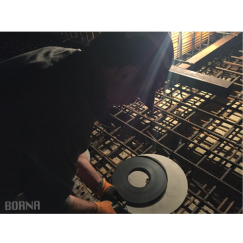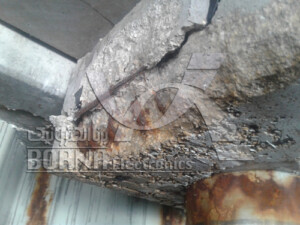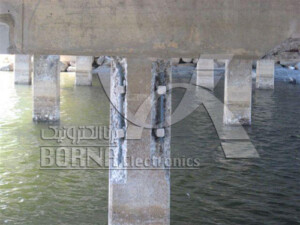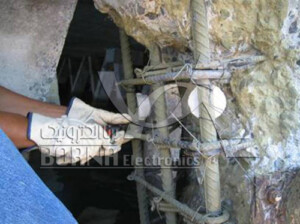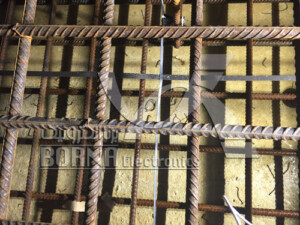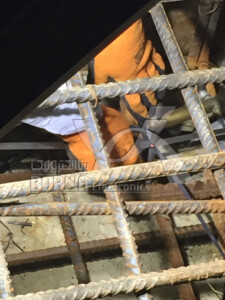Reinforced Concrete Cathodic Protection
Due to the increasing of construction and the use of reinforced concrete structures in industries, over time, the effects of strength reduction and destruction on these structures appear. This phenomenon will cause irreparable damage with increasing the life of the structure.
View of reinforced concrete structures destruction
Durability of reinforced concrete
The durability of reinforced concrete refers to the ability of concrete to withstand atmospheric factors, chemical attacks, abrasion, erosion and any process leading to its destruction. Durable concrete retains its shape and strength in the operation period, usually over decades, under the desired environmental conditions.
According to research, corrosion of steel bars in concrete is a major cause of premature failure and in some cases total destruction of reinforced concrete structures. Although steels naturally tend to undergo corrosion reactions but under normal condition, according to iron Pourbaix diagram, steel bars in concrete are naturally protected against corrosion due to formation of an alkaline environment (pH 12-13). It is caused by the cement hydration reaction which guarantees the immunity of the steel surface. This high pH environment results in the formation of a protective iron oxide film (passive layer) around the rebar, preventing the dissolution of the iron atoms and preventing corrosion in the reinforced concrete. As long as the iron oxide layer is present, the rebar remains virtually inactive electrochemically. The passive corrosion rate for steel in concrete is usually 0.1 μm per year. Without this passive film, steel would be corroded at a rate of at least a thousand times greater.
Iron Pourbaix diagram
Protective iron oxide film (passive layer) formed on steel reinforcement surface in concrete
If for any reason the protective oxide film is not formed or weakened or destroyed, the protection of the steel will fail and corrosion will occur. The degradation factors of steel reinforcement oxide film in concrete include:
- Excessive amounts of chlorine ions or other aggressive ions are present in the concrete (chlorine ions may be excessively due to the constituents of the concrete or to the penetrations from environment).
- Concrete alkalinity is lost by reacting with aggressive gases (carbon dioxide gas penetration and subsequent carbonation phenomenon)
- Concrete does not fully cover steel (direct exposure of steel to corrosive environment).
Effect of chlorine ions on reinforced concrete
Chlorine ions penetration is a very important phenomenon in the destruction of reinforced concrete structures. These ions are highly aggressive and cause corrosion by removing the inactive state of the reinforcement. Corrosion will begin when the concentration of chlorine ions in the vicinity of the reinforcement surface exceeds the critical level.
Effect of carbonation on reinforced concrete
Carbonation is another factor in the destruction of reinforced concrete structures that occurs as a result of carbon dioxide gas interactions with concrete alkali hydroxides, and unlike chlorine ions, this attack is delayed and in the first stage reacts carbon dioxide gas with concrete and causes intermediate compounds and subsequently lowers the pH and causes corrosion of the reinforcement.
The corrosion process of steel reinforcement which depending on the conditions resulting from the penetration of chlorine ions or carbonations, causes the concrete to crack, destroy the bond between the reinforcement and the concrete or Spallation the concrete, reducing the durability and life time and ultimately damaging the reinforced concrete structure.
Evaluation and determination of the start time of destruction in reinforced concrete
In order to evaluate the corrosion of steel bars and the destruction of reinforced concrete structures, the structural status of the structure must be carefully studied and engineered to use the best solution to prevent or protect the corrosion of the structure. These assessments generally include environmental conditions (temperature, annual humidity, applied loads, etc.), visual inspection, measurement of the extent and depth of penetration of chlorine ions and carbonations, evaluation of the electrical continuity of the reinforcements, measurement of the reinforcement potential to the concrete, measuring the concrete resistivity and the corrosion rate of reinforcement.
Therefore, with information on mixing and thickness of concrete cover, performance conditions and corrosion data obtained, it is possible to estimate the start time of destruction in reinforced concrete structures.
Cathodic protection systems in reinforced concrete
In section 6-3 of Iranian Concrete Regulations and section 9-6, part 9 of the National Building Regulations (Design and Implementation of Reinforced Concrete Buildings), corrosion of steel bars is one of the major factors in reducing concrete durability and necessitates protection of building reinforcements against corrosion. Also, in the Concrete durability National Regulation in the Persian Gulf and Oman Sea, the Iranian Ports and Offshore Structures Design Regulation (Offshore Platforms) and the Bridge Decks Cathode Protection Regulation, mention the requirements and methods of increasing concrete durability, including cathodic protection.
The corrosion of steel bars in concrete can be reduced by methods such as modifying the mixing and increasing the thickness of the concrete cover, surface insulation, and corrosion inhibitors or by the use of galvanized bars or epoxy-coated bars.
Another method that is widely used in under construction structures as a corrosion prevention and in existing structures to corrosion protection of bars is a cost effective method with high efficiency and reliability, cathode protection.
Applications of cathodic protection systems in reinforced concrete structures exposed to the atmosphere, adjacent to water or soil include:
-
-
-
-
- piles and decks of concrete bridges
- piles and decks of concrete jetties and platforms
- Concrete water tanks and pools (water desalination plants, treatment plants, etc.)
- Concrete dams (sections with bars or steel plates)
- Foundation and body of industrial concrete structures
- Foundation and body of concrete building
- etc.
-
-
-
The reinforced concrete cathodic protection is accomplished by two methods of sacrificial anode and impressed current. In the sacrificial anode cathodic protection method, the electric current is established by the natural potential difference between the two different metals, namely the steel reinforcement (cathode) and the more active metal (anode). In impressed current cathodic protection, the electric current is supplied by applying electrical potential using an external electrical source (transformer rectifier) and the anode is usually made of a stable combination. Each of these methods is selected based on the available facilities, constraints, and designer experience.
Selection criteria of cathodic protection method in reinforced concrete structures
|
Cathodic protection method |
Sacrificial anode |
Impressed current |
|
Need electricity |
No |
yes |
|
Lifetime protection |
Up to 10 years |
At least 20 years |
|
Probability of current interactions and destructive effects on adjacent structures |
No |
Depending on the anode bed |
|
The most common anode used |
Zinc |
Mixed metal oxide (MMO) |
The anodes used in the sacrificial method are usually magnesium, zinc, or aluminum, which zinc anodes being more commonly used than others. Mixed metal oxide (MMO) anode is also the most common impressed current anode that is used depending on the conditions in the form of tubular, ribbon, mesh ribbon, mesh and etc.
Installing zinc anodes in cathodic protection of reinforced concrete structures by sacrificial method
Installing ribbon MMO anodes in cathodic protection of reinforced concrete structures by impressed current method
The cathodic protection anodes can be mounted both on the exterior surface of the structure after construction and during construction and concreting. Another type of anode location is bed away from the structure. Regarding new structures due to the type of access and ease of installation, it is usually recommended that the anodes be installed even when the structure is running.
Borna Electronics Co. with over 30 years of experience in cathodic protection, declares its readiness to design, procurement, consultation and construction of cathodic protection systems for existing reinforced concrete structures (to protect corrosion and restoration of structures) or under construction (to prevent corrosion of structures) and implement cathodic protection monitoring systems for them.
